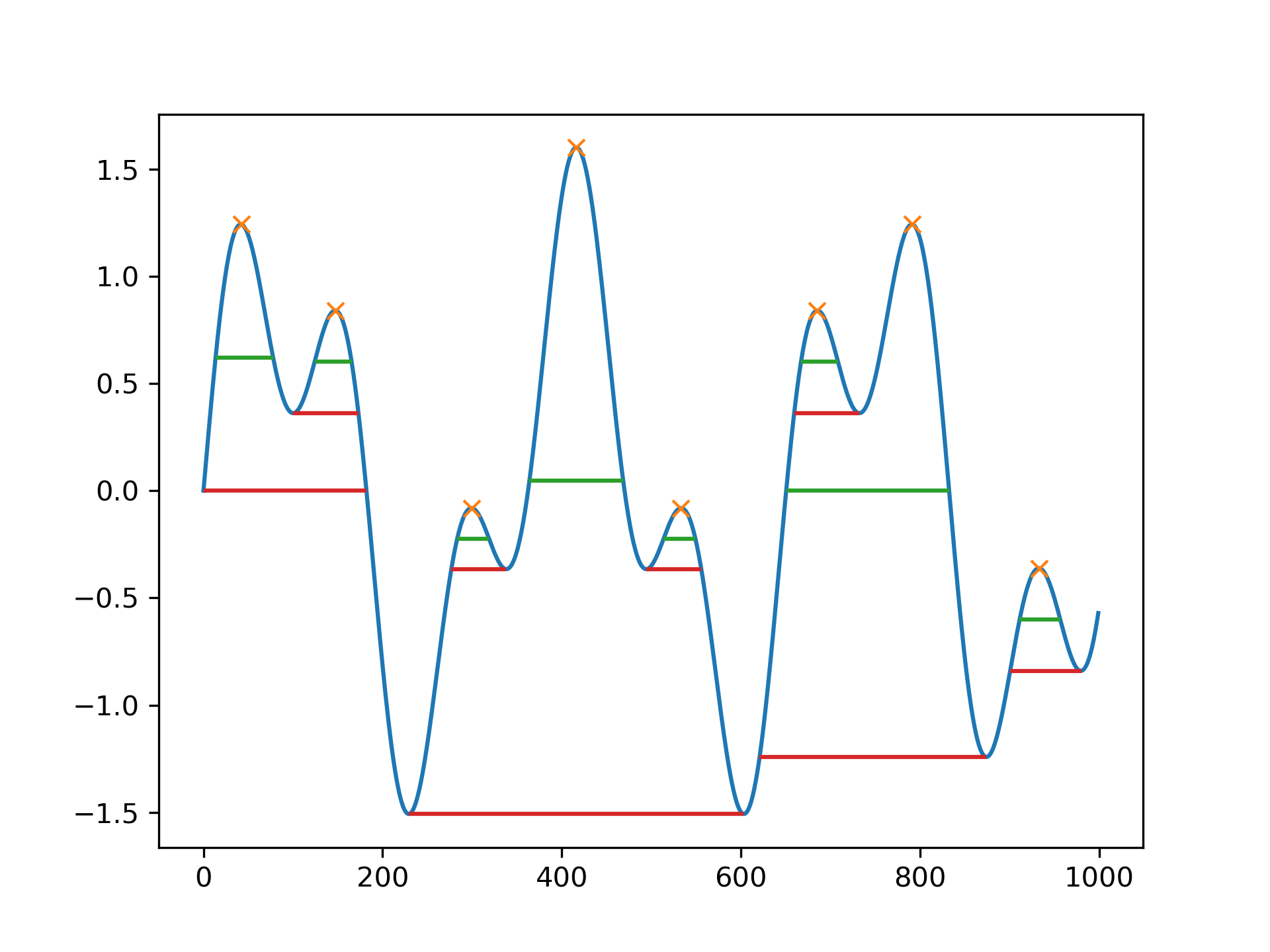peak_widths(x, peaks, rel_height=0.5, prominence_data=None, wlen=None)
This function calculates the width of a peak in samples at a relative distance to the peak's height and prominence.
The basic algorithm to calculate a peak's width is as follows:
Calculate the evaluation height $h_{eval}$
with the formula $h_{eval} = h_{Peak} - P \cdot R$
, where $h_{Peak}$
is the height of the peak itself, $P$
is the peak's prominence and $R$
a positive ratio specified with the argument :None:None:`rel_height`.
Draw a horizontal line at the evaluation height to both sides, starting at the peak's current vertical position until the lines either intersect a slope, the signal border or cross the vertical position of the peak's base (see peak_prominences
for an definition). For the first case, intersection with the signal, the true intersection point is estimated with linear interpolation.
Calculate the width as the horizontal distance between the chosen endpoints on both sides. As a consequence of this the maximal possible width for each peak is the horizontal distance between its bases.
As shown above to calculate a peak's width its prominence and bases must be known. You can supply these yourself with the argument :None:None:`prominence_data`. Otherwise, they are internally calculated (see peak_prominences
).
A signal with peaks.
Indices of peaks in x.
Chooses the relative height at which the peak width is measured as a percentage of its prominence. 1.0 calculates the width of the peak at its lowest contour line while 0.5 evaluates at half the prominence height. Must be at least 0. See notes for further explanation.
A tuple of three arrays matching the output of peak_prominences
when called with the same arguments x and :None:None:`peaks`. This data are calculated internally if not provided.
A window length in samples passed to peak_prominences
as an optional argument for internal calculation of :None:None:`prominence_data`. This argument is ignored if :None:None:`prominence_data` is given.
If :None:None:`prominence_data` is supplied but doesn't satisfy the condition 0 <= left_base <= peak <= right_base < x.shape[0]
for each peak, has the wrong dtype, is not C-contiguous or does not have the same shape.
The widths for each peak in samples.
The height of the contour lines at which the :None:None:`widths` where evaluated.
Interpolated positions of left and right intersection points of a horizontal line at the respective evaluation height.
Calculate the width of each peak in a signal.
Raised if any calculated width is 0. This may stem from the supplied :None:None:`prominence_data` or if :None:None:`rel_height` is set to 0.
find_peaks
Find peaks inside a signal based on peak properties.
peak_prominences
Calculate the prominence of peaks.
>>> from scipy.signal import chirp, find_peaks, peak_widths
... import matplotlib.pyplot as plt
Create a test signal with two overlayed harmonics
>>> x = np.linspace(0, 6 * np.pi, 1000)
... x = np.sin(x) + 0.6 * np.sin(2.6 * x)
Find all peaks and calculate their widths at the relative height of 0.5 (contour line at half the prominence height) and 1 (at the lowest contour line at full prominence height).
>>> peaks, _ = find_peaks(x)
... results_half = peak_widths(x, peaks, rel_height=0.5)
... results_half[0] # widths array([ 64.25172825, 41.29465463, 35.46943289, 104.71586081, 35.46729324, 41.30429622, 181.93835853, 45.37078546])
>>> results_full = peak_widths(x, peaks, rel_height=1)
... results_full[0] # widths array([181.9396084 , 72.99284945, 61.28657872, 373.84622694, 61.78404617, 72.48822812, 253.09161876, 79.36860878])
Plot signal, peaks and contour lines at which the widths where calculated
>>> plt.plot(x)
... plt.plot(peaks, x[peaks], "x")
... plt.hlines(*results_half[1:], color="C2")
... plt.hlines(*results_full[1:], color="C3")
... plt.show()

The following pages refer to to this document either explicitly or contain code examples using this.
scipy.signal._peak_finding_utils._peak_widths
scipy.signal._peak_finding._arg_peaks_as_expected
scipy.signal._peak_finding._arg_x_as_expected
scipy.signal._peak_finding.peak_prominences
scipy.signal._peak_finding._arg_wlen_as_expected
scipy.signal._peak_finding.find_peaks
scipy.signal._peak_finding.peak_widths
Hover to see nodes names; edges to Self not shown, Caped at 50 nodes.
Using a canvas is more power efficient and can get hundred of nodes ; but does not allow hyperlinks; , arrows or text (beyond on hover)
SVG is more flexible but power hungry; and does not scale well to 50 + nodes.
All aboves nodes referred to, (or are referred from) current nodes; Edges from Self to other have been omitted (or all nodes would be connected to the central node "self" which is not useful). Nodes are colored by the library they belong to, and scaled with the number of references pointing them